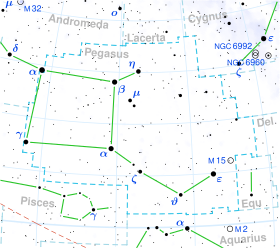32 Pegasi
| Observation data Epoch J2000 Equinox J2000 | |
|---|---|
| Constellation | Pegasus |
| Right ascension | 22h 21m 19.33896s[1] |
| Declination | 28° 19′ 49.8786″[1] |
| Apparent magnitude (V) | 4.81[2] (4.83 + 8.86)[3] |
| Characteristics | |
| Spectral type | B9III[4] |
| U−B color index | −0.19[2] |
| B−V color index | +0.00[2] |
| Astrometry | |
| Radial velocity (Rv) | +11.40[5] km/s |
| Proper motion (μ) | RA: +17.426[1] mas/yr Dec.: +7.122[1] mas/yr |
| Parallax (π) | 5.7814 ± 0.3196 mas[1] |
| Distance | 560 ± 30 ly (173 ± 10 pc) |
| Absolute magnitude (MV) | −1.82[6] |
| Details | |
| 32 Peg Aa | |
| Luminosity | 541[6] L☉ |
| Temperature | 11,403[7] K |
| Rotational velocity (v sin i) | 60[8] km/s |
| Other designations | |
| Database references | |
| SIMBAD | data |
32 Pegasi is a binary star[10] system in the northern constellation of Pegasus. It is visible to the naked eye as a faint, blue-white hued point of light with an apparent visual magnitude of 4.81[2] The system is located approximately 560 light years away from the Sun based on parallax, and is drifting further away with a radial velocity of +11.4 km/s.[5]
The brighter member of this system, designated component Aa, has visual magnitude 4.83 with a stellar classification of B9III,[4] matching a late B-type star with the luminosity class of a giant. It is spinning with a projected rotational velocity of 60 km/s,[8] and is radiating 541[6] times the luminosity of the Sun from its photosphere at an effective temperature of 11,403 K.[7]
The fainter secondary, component Ab, is of magnitude 8.86 with an angular separation of 0.50″ along a position angle of 288° from the primary, as of 2005. Visual companions include component B, at a 70.7″ separation from the primary and magnitude 10.73; C, at a separation from B of 3.2″ and magnitude 12.4; as well as D (separation from A of 42.8″ and magnitude 11.9) and E (separation from A of 58.3" and magnitude 11.9).[3]
References
[edit]- ^ a b c d e Brown, A. G. A.; et al. (Gaia collaboration) (August 2018). "Gaia Data Release 2: Summary of the contents and survey properties". Astronomy & Astrophysics. 616. A1. arXiv:1804.09365. Bibcode:2018A&A...616A...1G. doi:10.1051/0004-6361/201833051. Gaia DR2 record for this source at VizieR.
- ^ a b c d Ducati, J. R. (2002). "VizieR Online Data Catalog: Catalogue of Stellar Photometry in Johnson's 11-color system". CDS/ADC Collection of Electronic Catalogues. 2237. Bibcode:2002yCat.2237....0D.
- ^ a b Mason, Brian D.; Wycoff, Gary L.; Hartkopf, William I.; Douglass, Geoffrey G.; Worley, Charles E. (2001). "The 2001 US Naval Observatory Double Star CD-ROM. I. The Washington Double Star Catalog". The Astronomical Journal. 122 (6): 3466. Bibcode:2001AJ....122.3466M. doi:10.1086/323920. Vizier catalog entry
- ^ a b Hoffleit, D.; Warren, W. H. (1995). "VizieR Online Data Catalog: Bright Star Catalogue, 5th Revised Ed. (Hoffleit+, 1991)". VizieR On-line Data Catalog: V/50. Originally Published in: 1964BS....C......0H. 5050. Bibcode:1995yCat.5050....0H.
- ^ a b Gontcharov, G. A. (2006). "Pulkovo Compilation of Radial Velocities for 35 495 Hipparcos stars in a common system". Astronomy Letters. 32 (11): 759–771. arXiv:1606.08053. Bibcode:2006AstL...32..759G. doi:10.1134/S1063773706110065. S2CID 119231169.
- ^ a b c Anderson, E.; Francis, Ch. (2012). "XHIP: An extended hipparcos compilation". Astronomy Letters. 38 (5): 331. arXiv:1108.4971. Bibcode:2012AstL...38..331A. doi:10.1134/S1063773712050015. S2CID 119257644. Vizier catalog entry
- ^ a b Paunzen, E.; Schnell, A.; Maitzen, H. M. (2005). "An empirical temperature calibration for the Δa photometric system". Astronomy and Astrophysics. 444 (3): 941. arXiv:astro-ph/0509049. Bibcode:2005A&A...444..941P. doi:10.1051/0004-6361:20053546. S2CID 119436374.
- ^ a b Abt, Helmut A.; Levato, Hugo; Grosso, Monica (2002). "Rotational Velocities of B Stars". The Astrophysical Journal. 573 (1): 359–365. Bibcode:2002ApJ...573..359A. doi:10.1086/340590.
- ^ "32 Peg". SIMBAD. Centre de données astronomiques de Strasbourg. Retrieved 2019-07-01.
- ^ Eggleton, P. P.; Tokovinin, A. A. (2008). "A catalogue of multiplicity among bright stellar systems". Monthly Notices of the Royal Astronomical Society. 389 (2): 869. arXiv:0806.2878. Bibcode:2008MNRAS.389..869E. doi:10.1111/j.1365-2966.2008.13596.x. S2CID 14878976. Vizier catalog entry

